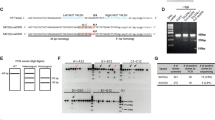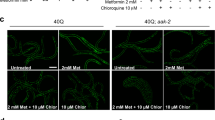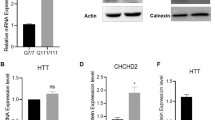Abstract
Huntington’s disease is an autosomal dominant disease associated with a mutation in the gene encoding huntingtin (Htt) leading to expanded polyglutamine repeats of mutant Htt (mHtt) that elicit oxidative stress, neurotoxicity, and motor and behavioural changes1. Huntington’s disease is characterized by highly selective and profound damage to the corpus striatum, which regulates motor function. Striatal selectivity of Huntington’s disease may reflect the striatally selective small G protein Rhes binding to mHtt and enhancing its neurotoxicity2. Specific molecular mechanisms by which mHtt elicits neurodegeneration have been hard to determine. Here we show a major depletion of cystathionine γ-lyase (CSE), the biosynthetic enzyme for cysteine, in Huntington’s disease tissues, which may mediate Huntington’s disease pathophysiology. The defect occurs at the transcriptional level and seems to reflect influences of mHtt on specificity protein 1, a transcriptional activator for CSE. Consistent with the notion of loss of CSE as a pathogenic mechanism, supplementation with cysteine reverses abnormalities in cultures of Huntington’s disease tissues and in intact mouse models of Huntington’s disease, suggesting therapeutic potential.
This is a preview of subscription content, access via your institution
Access options
Subscribe to this journal
Receive 51 print issues and online access
$199.00 per year
only $3.90 per issue
Buy this article
- Purchase on Springer Link
- Instant access to full article PDF
Prices may be subject to local taxes which are calculated during checkout




Similar content being viewed by others

References
Huntington’s Disease Collaborative Research Group. A novel gene containing a trinucleotide repeat that is expanded and unstable on Huntington’s disease chromosomes. Cell 72, 971–983 (1993)
Subramaniam, S. & Snyder, S. H. Huntington’s disease is a disorder of the corpus striatum: focus on Rhes (Ras homologue enriched in the striatum). Neuropharmacology 60, 1187–1192 (2011)
Paul, B. D. & Snyder, S. H. H2S signalling through protein sulfhydration and beyond. Nature Rev. Mol. Cell Biol. 13, 499–507 (2012)
Wang, R. Physiological implications of hydrogen sulfide: a whiff exploration that blossomed. Physiol. Rev. 92, 791–896 (2012)
Kimura, H. Hydrogen sulfide: its production, release and functions. Amino Acids 41, 113–121 (2011)
Morikawa, T. et al. Hypoxic regulation of the cerebral microcirculation is mediated by a carbon monoxide-sensitive hydrogen sulfide pathway. Proc. Natl Acad. Sci. USA 109, 1293–1298 (2012)
Yang, G. et al. H2S as a physiologic vasorelaxant: hypertension in mice with deletion of cystathionine γ-lyase. Science 322, 587–590 (2008)
Mangiarini, L. et al. Exon 1 of the HD gene with an expanded CAG repeat is sufficient to cause a progressive neurological phenotype in transgenic mice. Cell 87, 493–506 (1996)
Menalled, L. B. et al. Comprehensive behavioral and molecular characterization of a new knock-in mouse model of Huntington’s disease: zQ175. PLoS ONE 7, e49838 (2012)
Ishii, I. et al. Cystathionine γ-lyase-deficient mice require dietary cysteine to protect against acute lethal myopathy and oxidative injury. J. Biol. Chem. 285, 26358–26368 (2010)
Mani, S., Yang, G. & Wang, R. A critical life-supporting role for cystathionine γ-lyase in the absence of dietary cysteine supply. Free Radic. Biol. Med. 50, 1280–1287 (2011)
DiFiglia, M. et al. Aggregation of huntingtin in neuronal intranuclear inclusions and dystrophic neurites in brain. Science 277, 1990–1993 (1997)
Davies, S. W. et al. Formation of neuronal intranuclear inclusions underlies the neurological dysfunction in mice transgenic for the HD mutation. Cell 90, 537–548 (1997)
Sugars, K. L. & Rubinsztein, D. C. Transcriptional abnormalities in Huntington disease. Trends Genet. 19, 233–238 (2003)
Zhai, W., Jeong, H., Cui, L., Krainc, D. & Tjian, R. In vitro analysis of huntingtin-mediated transcriptional repression reveals multiple transcription factor targets. Cell 123, 1241–1253 (2005)
Dunah, A. W. et al. Sp1 and TAFII130 transcriptional activity is disrupted in early Huntington’s disease. Science 296, 2238–2243 (2002)
Ishii, I. et al. Murine cystathionine γ-lyase: complete cDNA and genomic sequences, promoter activity, tissue distribution and developmental expression. Biochem. J. 381, 113–123 (2004)
Yang, G., Pei, Y., Teng, H., Cao, Q. & Wang, R. Specificity protein-1 as a critical regulator of human cystathionine γ-lyase in smooth muscle cells. J. Biol. Chem. 286, 26450–26460 (2011)
Lin, M. T. & Beal, M. F. Mitochondrial dysfunction and oxidative stress in neurodegenerative diseases. Nature 443, 787–795 (2006)
Fu, M. et al. Hydrogen sulfide (H2S) metabolism in mitochondria and its regulatory role in energy production. Proc. Natl Acad. Sci. USA 109, 2943–2948 (2012)
Alston, T. A., Mela, L. & Bright, H. J. 3-Nitropropionate, the toxic substance of Indigofera, is a suicide inactivator of succinate dehydrogenase. Proc. Natl Acad. Sci. USA 74, 3767–3771 (1977)
Brouillet, E., Jacquard, C., Bizat, N. & Blum, D. 3-Nitropropionic acid: a mitochondrial toxin to uncover physiopathological mechanisms underlying striatal degeneration in Huntington’s disease. J. Neurochem. 95, 1521–1540 (2005)
Mustafa, A. K. et al. H2S signals through protein S-sulfhydration. Sci. Signal. 2, ra72 (2009)
Sen, N. et al. Hydrogen sulfide-linked sulfhydration of NF-κB mediates its antiapoptotic actions. Mol. Cell 45, 13–24 (2012)
Vandiver, M. S. et al. Sulfhydration mediates neuroprotective actions of parkin. Nature. Commun. 4, 1626 (2013)
Yang, G. et al. Hydrogen sulfide protects against cellular senescence via S-sulfhydration of Keap1 and activation of Nrf2. Antioxid. Redox Signal. 18, 1906–1919 (2013)
Szabo, C. Hydrogen sulphide and its therapeutic potential. Nature Rev. Drug Discov. 6, 917–935 (2007)
Droge, W. Oxidative stress and ageing: is ageing a cysteine deficiency syndrome? Phil. Trans. R. Soc. Lond. B 360, 2355–2372 (2005)
Fox, J. H. et al. Cystamine increases l-cysteine levels in Huntington’s disease transgenic mouse brain and in a PC12 model of polyglutamine aggregation. J. Neurochem. 91, 413–422 (2004)
Cyr, M., Caron, M. G., Johnson, G. A. & Laakso, A. Magnetic resonance imaging at microscopic resolution reveals subtle morphological changes in a mouse model of dopaminergic hyperfunction. Neuroimage 26, 83–90 (2005)
Acknowledgements
We thank J. C. Troncoso and O. Pletnikova for providing the human post-mortem tissue samples; D. Krainc for the constructs CMV-SP1 and TAF4; M. MacDonald for the striatal Q7 and Q111 cell lines; and the Cure Huntington’s Disease Initiative (CHDI) for the Q175 mice tissues. This work was supported by United States Public Health Service Grant MH18501 to S.H.S. and by the CHDI. M.S.V. and R.X. are supported by the National Institutes of Health Medical Scientist Training Program Award.
Author information
Authors and Affiliations
Contributions
B.D.P. and S.H.S. designed the research. B.D.P., J.S., R.X., M.S.V. and J.C. conducted experiments. B.D.P., J.S. and R.X. analysed data. A.M.S. prepared plasmid constructs and provided technical assistance. B.D.P. and S.H.S. wrote the paper.
Corresponding author
Ethics declarations
Competing interests
The authors declare no competing financial interests.
Extended data figures and tables
Extended Data Figure 1 CSE expression is not altered in the brain in amyotrophic lateral sclerosis, multiple sclerosis and spinocerebellar ataxia.
a, Western blots show that CSE expression in the motor cortex of samples from controls and patients with amyotrophic lateral sclerosis (ALS) showing substantial neurodegeneration in the motor cortex are similar. Extracts were prepared from the motor cortex and analysed for CSE expression using anti-CSE antibodies and β-actin as a loading control. b, Expression of CSE is not altered in the corpus callosum of patients with multiple sclerosis (MS), where multiple lesions, demyelination and decrease in oligodendrocytes was observed in the corpus callosum of the brain. c, d, Levels of CSE do not change in the cerebral cortex (c) or cerebellum (d) of patients with spinocerebellar ataxia (SCA). Neuropathological analysis of the brains of these patients revealed severe neuronal loss and gliosis in the cerebellum.
Extended Data Figure 2 Cse−/− mice are more vulnerable to stress induced by 3-nitropropionic acid.
Wild-type and Cse−/− male mice at 8 months of age were injected with a single dose of 3-nitropropionic acid (3-NP) (100 mg kg−1), and lysates were prepared 24 h later from the striatum and cortex and analysed for oxidative stress. a, b, Striata (a) and cortex (b) of Cse−/− mice show elevated protein oxidation as measured by protein carbonylation, which is more pronounced in the striatum. n = 3 (means ± s.e.m.). c, d, Cse−/− mice also show augmented levels of protein nitration in the striatum (c) and cortex (d) in comparison with wild-type mice. Note the increased basal level of protein oxidation in the Cse−/− mice.
Supplementary information
Clasping test with a wild type mouse on a control diet
An 11-week old wild type mouse exhibiting a normal righting response when suspended by the tail. The mouse was placed on a control diet containing 0.3% cystine and regular drinking water. (MOV 7054 kb)
Clasping test with an R6/2 transgenic mouse on a control diet
An 11-week old R6/2 transgenic wild type mouse with motor deficits clasping its hind limbs almost immediately when suspended by the tail. The R6/2 mouse was placed on a control diet containing 0.3% cystine and regular drinking water. (MOV 6740 kb)
Clasping test with an R6/2 transgenic mouse on N-acetyl cysteine and a high cysteine diet
An 11-week old R6/2 transgenic mouse showing almost no clasping when suspended by the tail. The R6/2 mouse was placed on a diet containing 0.8% cystine and 20 mM N-acetylcysteine in the drinking water. (MOV 6394 kb)
Rights and permissions
About this article
Cite this article
Paul, B., Sbodio, J., Xu, R. et al. Cystathionine γ-lyase deficiency mediates neurodegeneration in Huntington’s disease. Nature 509, 96–100 (2014). https://doi.org/10.1038/nature13136
Received:
Accepted:
Published:
Issue Date:
DOI: https://doi.org/10.1038/nature13136
This article is cited by
-
Enzyme-independent catabolism of cysteine with pyridoxal-5′-phosphate
Scientific Reports (2023)
-
Mechanism-based and computational modeling of hydrogen sulfide biogenesis inhibition: interfacial inhibition
Scientific Reports (2023)
-
Understanding the mechanistic roles of environmental heavy metal stressors in regulating ferroptosis: adding new paradigms to the links with diseases
Apoptosis (2023)
-
Electrochemical sensor for hydrogen sulfide detection using electrocatalysis-assisted amplification and chemical reaction-mediated signal enhancement
Microchimica Acta (2023)
-
Hydrogen Sulphide-Based Therapeutics for Neurological Conditions: Perspectives and Challenges
Neurochemical Research (2023)
Comments
By submitting a comment you agree to abide by our Terms and Community Guidelines. If you find something abusive or that does not comply with our terms or guidelines please flag it as inappropriate.


